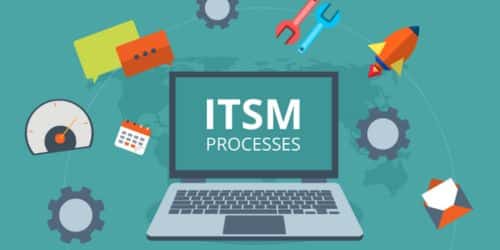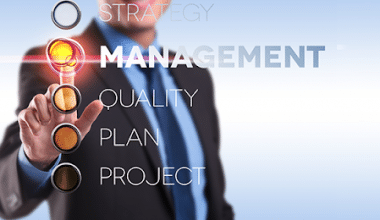IT service management (ITSM) is simply the process of implementing, administering, and providing IT services. ITSM conducted to the highest standards will benefit the organization in a variety of ways, which we’ll explore in this article. In addition to that, we’ll see the various ITSM tools and certifications available for you to explore.
What is ITSM?
IT service management, also known as ITSM, is essentially the process by which IT professionals manage the end-to-end delivery of IT services to clients. This comprises all of the processes and activities involved in designing, developing, delivering, and supporting IT services.
The premise that IT should be supplied as a service is central to ITSM. A common ITSM scenario would entail requesting new gear, such as a laptop. You would submit your request via a portal, fill out a ticket with all pertinent details and initiate a repeating cycle. The ticket would then be routed to the IT team’s queue, where new requests are prioritized and resolved.
The Importance of ITSM
ITSM is advantageous to your IT team, and service management principles can benefit your entire organization. ITSM increases efficiency and productivity. A structured approach to service management also aligns IT with business goals by standardizing service delivery based on budgets, resources, and results. It lowers expenses and hazards while also improving the consumer experience.
Some of the most prevalent ITSM benefits include:
- Integrating IT teams with business priorities, as measured by success metrics
- Facilitating cross-departmental collaboration
- Bringing together IT and development teams through improved project management methods
- Enabling IT teams to share information and improve continuously
- Increasing request coordination for better service
- Increasing customer-centricity through self-service and improved workflows
- Reacting to significant incidents more promptly and preventing future ones
All of this reduces expenses and leads to improved service.
ITSM Processes
What exactly are ITSM processes? ITIL version 4 recently shifted from recommending ITSM “processes” to introducing 34 ITSM “practices” in order to “consider elements such as culture, technology, information and data management to get a holistic vision of the ways of working.” This more comprehensive approach better reflects the realities of modern organizations.
Among the key ITSM processes are:
#1. Handling of Service Requests
Service request management is a standardized system for addressing a wide range of client service requests, such as requests for application access, software upgrades, and hardware updates. The service request workstream frequently contains repeating requests and benefits substantially from providing expertise to customers and automating some operations.
#2. Management of Information
Knowledge management is the process of developing, distributing, utilizing, and managing an organization’s knowledge and information. It refers to an interdisciplinary approach to attaining corporate goals through the most effective use of information.
#3. IT Asset Administration
IT asset management (also known as ITAM) is the process of ensuring that an organization’s assets are properly identified, installed, maintained, improved, and disposed of. Simply put, it is ensuring that your organization’s important assets, both actual and intangible, are recorded and employed.
#4. Handling of Incidents
The process of responding to an unanticipated occurrence or service interruption and restoring the service to its operating state is known as incident management. With all of the digital services that businesses rely on today, there are more possible failure points than ever before, so this process must be ready to respond to and resolve issues as soon as they arise.
#5. Problem Solving
The practice of discovering and addressing the causes of problems in an IT service is known as problem management. Issue management includes not only locating and resolving occurrences but also recognizing and comprehending the underlying reasons for an incident and determining the best strategy to eradicate the main causes.
#6. Management of Change
Change management guarantees that standard protocols are followed for the efficient and timely handling of all IT infrastructure changes, whether they be rolling out new services, managing existing ones, or fixing code bugs. Good change management gives context and transparency in order to avoid bottlenecks and minimize risk.
ITSM Tools
There are numerous ITSM tools on the market. Here are some of the most popular
#1. NinjaOne
NinjaOne provides a platform for remote monitoring and management that supports all devices and users. It includes RMM, endpoint management, patch management, backup, service desk, remote access, and other features. It can deliver real-time information about all of your IT assets. In addition, it will assist you with IT documentation as well as software deployment.
#2. SuperOps.ai
To provide great IT services to clients, SuperOps.ai’s comprehensive ITSM platform is a natural combination of modern ticketing and simple asset management.
SuperOps.ai is a single-pane-of-glass solution for IT and service teams that handles ticketing, inventory, invoicing, billing, and asset management. It has a rich, constantly-increasing ecosystem of third-party integrations to enable you to increase the capabilities of your platform and bring your tech stack closer together.
#3. Jira Service Management
Each team size can benefit from the self-managed solution. There are two options. Data Center ($12000 per year) and Server ($16500 one-time purchase). It is free to try for 30 days.
Jira is an excellent service desk solution for any team, including human resources and legal. By combining Confluence with Jira, you will have a knowledge base. This platform can be deployed both on-premises and in the cloud. It is designed for teamwork and offers advanced automation.
#4. Salesforce
Salesforce provides an IT service management platform that focuses on improving the client experience. The platform facilitates client engagement through a variety of digital platforms. Salesforce also assists you in the creation of intelligent workflows that can automate your company activities.
Salesforce may work wonders for call center companies by providing clever productivity tools that improve managerial efficiency. Salesforce’s finest feature has to be its AI-driven system, which allows firms to upsell and increase revenue.
#5. Zendesk ITSM
Zendesk ITSM is a support ticketing system and customer service software. It offers a live chat feature as well as messaging. The support strategy will assist you in tracking, prioritizing, and resolving client tickets.
#6. Wrike
Wrike offers software for managing various workstreams. It includes the functionality to keep track of teams and provide visibility into their work. It is a unified, robust platform that includes all IT project management tools.
#7. SolarWinds Service Desk
Previously, the Samanage service platform was SolarWinds Service Desk. You will be able to automate service management throughout your organization in 150 different ways with SolarWinds service desk.
ITSM Certification?
Because of its popularity and significance, ITSM training is now required. Fortunately, whether you’re a rookie trying to hone your skills or an experienced expert looking to expand your knowledge, there are a variety of ITSM certifications accessible. One such ITSM certification is ITIL, and we’ll look at the various options available in this section.
ITIL certifications are vendor-agnostic and provide a flexible approach to the ITIL framework. It is made up of a series of credentials that focus on various parts of ITIL best practices. Its tiered structure allows candidates to easily select their individual discipline concentration and key areas of interest. The certification levels in the ITIL 4 framework are classified as follows:
#1. ITIL Foundation
This course introduces applicants to ITIL 4, allowing them to view ITSM as an end-to-end operating model for the design, delivery, and ongoing evolution of technology-enabled goods and services.
This certification is best suited to people who need to obtain a fundamental grasp of the ITIL framework, those who wish to use ITIL to improve their ITSM, or those whose businesses have recently implemented ITIL and want to gain a general awareness of it.
The components of this certification include the ITIL 4 guiding principles, the four dimensions of service management, the ideas of Lean, Agile, and DevOps and how they generate business value, and how ITIL practices specified in ITIL 4 may maintain the value of present processes.
#2. ITIL 4 Managing Professional
This certification provides both a practical and technical understanding of how to run successful IT-enabled services, teams, and procedures. It covers fundamental service management operations and monitors all sorts of engagement interactions between a service provider and its users, clients, providers, and partners. It includes the following elements:
- Customer delivery of innovative and dependable technology-assisted services in a powerful environment
- How to Provide Support for IT-Enabled Products and Services
- Tools for increasing stakeholder satisfaction
- Learn about Agile and Lean approaches, as well as technological practices and technologies like cloud, automation, and automated testing.
- Acquire the practical skills required to build an IT organization that is constantly evolving.
#3. ITIL 4 Strategic Leader
There are two modules in the ITIL4 Strategic Leader certification:
- ITIL 4 Strategist Direct Plan & Improve and
- ITIL 4 Leader Digital & IT Strategy.
Obtaining this certification indicates that you have a thorough understanding of how Technology drives and leads company strategy. It outlines techniques for present and aspiring IT executives to develop and implement digital concepts that meet emerging technology concerns. This certification is intended to:
- Provide practical and strategic advice on managing teams at various levels.
- Let digital business plan to work in tandem with IT strategy.
- Learn how emerging technologies are causing upheaval in organizations.
- Learn how to React to Technological Advances
#4. ITIL Master Certificate
The ITIL Master certification validates a candidate’s competence to apply ITIL ideas, processes, and procedures in a professional environment.
Candidates for the ITIL Master certification must be able to demonstrate and defend how they have personally chosen and utilized a variety of ITIL Framework expertise, ideas, and procedures, as well as supporting management approaches, to achieve the desired business results.
Why is it Necessary to Obtain an ITSM Certification?
The following are some of the most significant advantages of getting an ITSM certification:
#1. ITIL Framework and Processes Understanding
ITIL certification program participants can gain a thorough understanding of ITSM activities that can be used to drive business success in IT enterprise contexts.
#2. Maintain Consistent Compliance with Global ITSM Standards
ITIL meets a variety of international quality standards, including the ISO/IEC 20000 worldwide standard for IT service management systems. Because of the worldwide scope and compatibility of the ITIL framework with other leading concepts, certified ITIL specialists can apply their skills to a wide range of enterprises and sectors, even those in other countries.
#3. Employers prefer certified professionals.
Employees with job-specific qualifications are more confident, dependable, and informed; they become skilled in their roles sooner after being employed; and they accomplish their tasks more successfully, according to studies. These factors demonstrate why ITIL-certified personnel are sought after for IT employment.
You may set your firm up for success by embracing ITSM principles and obtaining ITSM certification. Call ITarian right once to streamline your IT management strategy.
ITIL vs. ITSM
If your company wants to improve its grasp of how it currently delivers IT assistance, it must first comprehend the distinction between ITSM and ITIL (Information Technology Management System vs Information Technology Infrastructure Library). In brief, ITSM refers to the full collection of processes that a business employs to manage its IT services for clients, whereas ITIL refers to a specific ITSM framework.
ITSM vs ITIL: What They Mean
ITSM Definition
IT Service Management (ITSM) refers to the process of managing IT operational services. IT service management (ITSM) explains how an organization enables IT service delivery, including the management of all resources and people engaged in providing it, such as IT administrators, service providers, vendors, and clients. ITSM encompasses a number of critical tactical IT principles, including, but not limited to, the operation of an IT service desk (including helpdesk functionality).
ITIL Definition
ITIL is an acronym that stands for Information Technology Infrastructure Library. As previously said, it is a set of specific IT service management functions that focus on coupling IT services with business goals. ITIL is a critical, best-practice framework for ITSM, and using ITIL concepts can help you operate more successfully by allowing an organization to optimize corporate value through the use of technology.
ITIL, which was created in the 1980s by the British government’s Central Computer and Telecommunications Agency (CCTA), has grown from a collection of over 30 books to a streamlined group of 7 books that define the framework’s most recent versions. The most recent edition, ITIL 4, reflects the increased adoption of cloud-based and digital technologies by enterprises across various industries. As a result, it emphasizes:
- Technology integration with the whole corporate structure and culture
- Collaboration between departments
- Customer comments
The ITIL approach is the most frequently utilized set of principles for treating your firm like a client and providing services in the most efficient manner. Its most recent incarnation might be viewed as an embracing of business agility in IT.
ITSM vs ITIL: What’s the Difference?
The difference between ITSM and ITIL is primarily defined by the relationship between the two concepts. ITSM explains how a specific organization manages its IT services, whereas ITIL is a framework for ITSM that specifies a specific set of processes and rules for IT service providing.
The evolution of the two concepts can help explain the differences between ITSM and ITIL. ITSM has evolved since its inception to meet the requirement for standardization across businesses. As ITSM evolved, so did a variety of ITSM frameworks from various businesses and parts of the world. ITIL is one of these frameworks, and it is the most extensive and widely used.
The concept of project management and the many project management approaches available would be a suitable example. While project management refers to the standardization of methods used by any given business to handle projects, methodologies such as Agile and Waterfall prescribe their own specialized frameworks (i.e., specific processes and standards) for managing projects in specific ways.
Is ServiceNow an ITSM?
Indeed, ServiceNow is an ITSM solution.
Is SAP an ITSM system?
SAP is an ITSM that is compliant with and certified by the Information Technology Infrastructure Library (ITIL).
What Are The 4 Ps of Service Management?
People, processes, products or technology, and partners or suppliers are the four Ps of service management.
Who Makes Use of ITSM Tools?
IT service desks and IT service delivery functions are the most common users of ITSM technologies.
In Summary
ITSM is at the heart of organizational modernization. As the emergence of software-powered services continues, IT service teams across enterprises are enabling people and teams to provide value more quickly. The IT team’s function has shifted from supporting the company to differentiating the business. It is time to shift ITSM methodologies to emphasize cooperation, ease of use, and faster value delivery.
Related Articles
- Best 20 Software For Change Management In 2023: Detailed Reviews
- DECISION-MAKING FRAMEWORK: Best Framework For Effective Decision making
- ITIL: Meaning, Foundation, Process & Certificate
- SERVICE MANAGEMENT SYSTEMS: Definition, Components, and Importance






